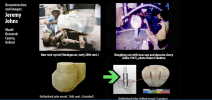Many thanks for that. I think he's still missing a few other criticisms that could be levied against the original claims. The one that jumps out to me specifically is covered with his warning not to confuse precision with polishing, but he could hammer it home more - and that's the "precision" of the wall width. How wide are the walls of the vessel? In some places, they're precisely 2mm wide. In other places they're precisely 4mm wide. So, in reality, they're 3mm +/- 1mm wide. So 3mm, but accurate to one part in three. How is such a wide range worthy of the epithet "precise"? (The desirable property from an engineering perspective of course being "accuracy", not "precision" - "Pi=2.781828" is a very precise statement, but with horrific accuracy. This ties in with his precision vs. polishing thrust - precision certainly can aid prettiness, a useful attribute for an artisenal piece.)
I just wish I wasn't broke currently, I think I'd be up for a replica for $100! Heck, I'd buy two and sell one!

